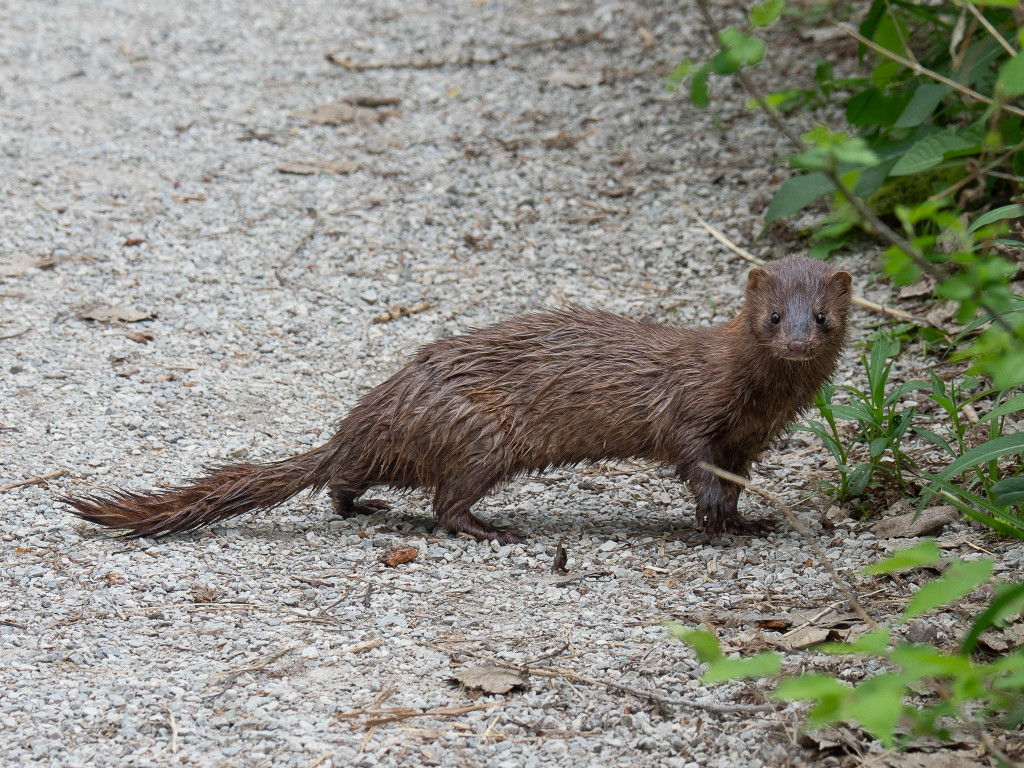
By Monica Macoubrie, Wildlife Education Specialist
In the quiet corners of the Midwest, among the rustling reeds and meandering streams, lurks a creature of remarkable stealth and cunning: the American mink (Neovison vison). With its sleek fur and sinuous movements, this mysterious carnivore prowls the water’s edge, weaving through the tangled undergrowth in search of its next meal.
While they are rarely seen by humans, the American mink is becoming increasingly prevalent in Nebraska’s landscapes and becoming an integral part in our aquatic ecosystems.
What Is a Mink?
The American mink is a small, semi-aquatic mammal native to North America. Belonging to the family Mustelidae, which also includes weasels, otters and ferrets, the mink is characterized by its slender body, short legs and long, bushy tail. Typically measuring around 12-18 inches in length, excluding its tail, and weighing between 1-3 pounds, the mink is well-adapted to both terrestrial and aquatic environments.
Its thick, water-resistant fur ranges from dark brown to black and provides insulation against cold temperatures, allowing the American mink to thrive in a variety of habitats, from marshes and rivers to forests and farmland.
Mysterious Marauders
Despite its diminutive size, the American mink holds a significant ecological role as a top predator within its ecosystem. With its sharp claws, swift reflexes and keen senses, the mink is an adept hunter, preying upon a diverse array of species including fish, amphibians, birds and small mammals. By regulating the populations of these prey species, the mink helps prevent overgrazing, overpopulation and potential ecosystem imbalances.
Furthermore, as an apex predator, the mink exerts a top-down influence on its ecosystem, shaping the distribution and behavior of other species within its food web. Its presence dictates patterns of resource use, spatial dynamics and even community structure. Through its hunting activities, the mink contributes to the cycling of nutrients and energy within its ecosystem, ultimately fostering a healthier and more resilient natural environment.
Reproduction and Family Dynamics
American mink reproduction is a seasonal affair, typically occurring in late winter or early spring. During this time, male mink embark on a quest to find suitable mates, marking their territories with scent signals to attract females and deter rival males.
Once a pair bonds, they engage in elaborate courtship rituals, which may involve chasing, play fighting and vocalizations. After mating, the female undergoes a gestation period lasting around 40-75 days, depending on factors such as environmental conditions and the availability of food resources. In spring, she gives birth to a litter of typically 3-6 kits, although larger litters are not uncommon. These newborn mink are blind, hairless and entirely dependent on their mother for warmth and nourishment.
Over the following weeks, the kits grow rapidly, developing their fur coats and gradually opening their eyes. The mother diligently cares for her offspring, providing them with milk and teaching them essential survival skills such as hunting and navigation. By the time summer arrives, the young mink are weaned and ready to venture out on their own, although they may remain with their mother for several months as they hone their hunting abilities and establish their own territories.
Scented Signals
Mustelids are known for their “musty” smell, and like others in this family, mink use scent to communicate and establish territory. These small carnivores possess specialized scent glands located near their anus, which they use to produce a pungent secretion containing unique chemical signatures. By rubbing their anal glands on objects such as rocks, trees or vegetation, mink leave behind scent markers that convey information about their identity, reproductive status and territorial boundaries to other individuals.
Scent marking also plays a role in mate attraction, as males and females may deposit scent marks to signal their availability for breeding. Additionally, scent marking helps deter potential rivals and maintain social hierarchies within the mink population. Through this olfactory form of communication, American mink effectively navigate their complex social and ecological landscape, asserting their presence and dominance in their environments.
Conservation Challenges
Conservation concerns surrounding American mink primarily revolve around their impact as invasive species in certain regions outside their native range. Introduced populations of mink, particularly in areas such as Europe, have been linked to declines in native wildlife, particularly among ground-nesting birds and waterfowl. Mink are efficient predators and their presence in non-native ecosystems can disrupt local food webs and put additional pressure on already vulnerable species.
Furthermore, in regions where mink fur farming is practiced, escapees or deliberate releases can lead to the establishment of feral populations, further exacerbating conservation issues. Efforts to control or eradicate introduced mink are challenging due to the animal’s elusive nature and ability to exploit a variety of habitats.
In their native range, habitat loss, pollution and climate change pose threats to American mink populations, highlighting the need for comprehensive conservation strategies to safeguard their future.
As Nebraska continues to evolve and face new environmental challenges, the conservation of American mink remains an integral component of preserving the state’s biodiversity. By recognizing the importance of these charismatic carnivores and implementing proactive conservation measures, we can ensure that future generations of Nebraskans can continue to marvel at the enigmatic beauty of the American mink.
